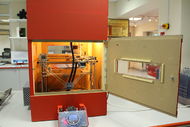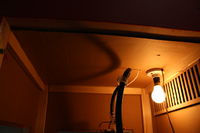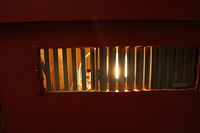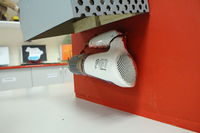Heated Build Chamber
Release status: working
| Description | Heated build chamber build.
|
| License | |
| Author | |
| Contributors | |
| Based-on | |
| Categories | |
| CAD Models | none
|
| External Link |
Contents
Introduction
The usage of a heated build chamber is under patent by Stratasys; US6722872, US7297304 and US20040104515. In many countries, a heated build chamber can therefore not be sold or be used for the production of commercial parts. The disclosure on how to fabricate a heated build chamber might also be illegal as it is protected by patent. Thhis page was originally made by one user to demonstrate a heated build chamber (HBC) he or she built. It 'works incredibly well' and 'it has almost completely eliminated the warping effect for ABS parts despite the fact that I have no heated bed. The only bed adhesion I do have is blue painters tape.'
Overview
The HBC is nothing fancy at all and can be built from very cheap parts and the most basic of woodworking tools. The system consists of a wooden box made from thin mdf sheets with wood beams acting as a skeleton.
Insulation
Double-ply cardboard is then glued to the inside of the box for insulation.
Heat vents
After the box has been insulated a heat vent needs to be made so that the temperature of the chamber can be regulated. I made a lasercut vent consisting of sliding vertical slots. This system can easily be made with hand tools, I just used a lasercutter because it was easier and less time consuming
Heating element
The final part of the heated build chamber is the heating element. In my case I used a hair dryer and it works perfectly for its job. I glued it to a right-angle piece of PVC pipe so that all the air would be directed inside.
Electronics
As for solder reflow oven controllers, various options exist in 2017 to monitor temperature, time and to control heating elements ranging from a hairdryer-below to a toaster oven, as used for making surface mounted electronics circuit boards.
- 240V is LETHAL TO TOUCH, if you use a hairdyer, consider a 12V hairdryer connected to the heated bed connectors on the Reprap controller.
Arduino Pro Micro [1], 0xPIT, 2017, Open_source_hardware, MIT license
Arduino Nano [2], Dasaki, 2017, Open_source_hardware, MIT license
Operation and Precautions
In order to get good results experimentation is required. The temperature of the chamber is controlled by the speed setting on the hair dryer and how open the vents are. Personally I keep the hair dryer on mode 2 and one of the three vents closed, for larger parts all three vents are closed and the warping decreases even more.
- PRECAUTION Personally this system hasn't failed me yet and it poses no serious risk but be careful because this thing is still a FIRE hazard and I have never left it unattended.
Results
Below are some images of the effectiveness of the HBC. The red part is 10 by 10 cm and the white part is roughly 18 cm across. Both were printed on blue painters tape with no heated bed.
Different (simpler) version of heated chamber
This is a different and simpler version of heated chamber without an active heating (using only the heat dissipated from the heatbed and hotend).
Build
It is built around a MendelMax and made from wood, which has been treated with an indoor water-soluable paint to last and held together with simple iron L shaped pieces from hardware store. It has a few holes in it and a plexiglass front door, so that I can watch my machine in action! It was meant mostly as a digestory to hold the fumes from ABS in and filter them through a carbon filter, using a 120mm PC fan (which proves to be sufficient as well! - no smell in my room anymore), but works as a heated room too. There were no big problems in building it - in fact it was rather easy and cheap. I can only recommend this way to anyone having warping problems or trouble with the fumes and not wanting to spend two months building a complex solution as the one above. It can also be very easily upgraded, so you can use it as a starting point and eventually make it better.
Electronics
The electronics are mounted on the outside to prevent overheating and the wires go through one of the holes into the box, so you shouldn't be very limited in raising the inside temperature. The limiting factor could be the motors (which should handle something up to 80°C without problems) and potentially any PLA parts you have on your machine (mine is from ABS, so that should be quite fine). ...Wonder if ABS can deform in any way at higher temperatures (like glass does over time for example, due to its amorphity)...
It also has two high power LEDs, which were powered from the 5V line of the ATX PS, used to power the printer, as ATX PSs usually require about 1A of current output on the 5V line to deliver 12V properly (now I use a different PS). Also a fan with selectable voltage (a simple three position switch selects 12V, 5V and 0V) to regulate speed and noise is included, driving the air through a carbon filter out of the box (or not when turned of... :)).
Other designs
- See http://hydraraptor.blogspot.com/2010/06/wooden-overcoat.html for a passive temperature controlled chamber design from Nophead.
Summary
In addition to heat and fumes control, the box could serve some other purposes, I think; Maybe with some changes to some of the parts on the 3D printer, it could be incorporated into the box more strongly. Than the box could be used to transport the printer much easier and in one piece with the electronics and all... And maybe it would even solidify the printer, giving it more accuracy at higher speeds...
All in all it is working great and I can only recommend building something similar! No smell of ABS (which was quite a problem before), much less warping and cleaner, safer and contained worplace for the machine. Video of it in action
Other ideas
The purpose of a heated build chamber is to reduce the cooling caused by open air. This can help reduce warping with tall/thin printed features and conserve energy.[3] The sealed nature of these chambers can also be used contain fumes from heated plastics.
Turkey Bag
A plastic turkey bag is designed to withstand the high temperatures and can be an ideal, cheap way to create a heated build chamber.
Multiple bags can be used (ie multiple layers) to decrease heat lost by conduction. They do not stop heat lost through infrared radiation.
Mylar
Mylar (commonly seen as "metal" balloons and space blankets) has great thermal reflection properties and can be inexpensive. As most consumer Mylar is not rated for high temperatures, care should be taken to be sure it doesn't come into contact with the heated build platforms or extruders. High temperature Mylar can be purchased at a higher cost.
Ayoue
A heated chamber can be created with an Aoyue 968A+ SMD Digital Hot Air Rework station. Several open hardware boards, such as the Smoothieboard, can toggle a MOSFET at predefined temperatures. The MOSFET can be used to toggle a relay switch which switches the SMD Digital air Rework station on or off. The switch should not toggle the power supply, but must be connected to the controller board inside the SMD Hot Air Rework station. If the Ayoue is opened up, it will become clear that a switch is connected to a board inside. This switch must be made digital. The usage of the switch instead of simply turning the complete Ayoue on and off results in a controlled shut down.
HotWind Premium
If the DIY option is too much work, an industrial solution could be to buy the Hotwind premium.
Gallery
These photos show the completed box. Description of photos is below.















